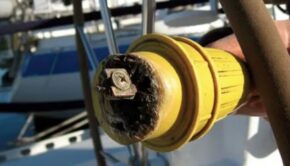So easy a Curmudgeon can do it
Published on February 12th, 2019
For more than 35 years, Practical Sailor has been taking the guesswork out of boat and gear buying with bold, independent boat tests, and product-test reports for serious sailors and boaters. In this report, they provide the basics about winch service.
While using the right winch grease is important, servicing the winch before the grease turns to gum, washes out, or the pawls start to hang up is more important. Makers recommend annual servicing, but racers and full-time cruisers may go one to three years, and weekend sailors might stretch it a bit further.
Three years really would be the max, unless you can live with increased wear. If you go any longer, you risk increased wear and even damage. If the pawls hang up and the drum releases, parts can break, and people can get hurt as the handle whips around.
Here is a quick review of the basics of winch servicing:
1. Read the instructions. Most winches come apart by loosening a single screw or removing a clip, with little risk of losing important parts. If in doubt, tape a cardboard box around the winch to catch any strays; the caged bearings can stick to the drum and fall out when it is removed. Note the orientation of the line stripper. Move the parts to a safe work area.
2. Work on one winch at a time. Seemingly identical winches a few years apart in age can have significantly different parts. We’ve wasted a few minutes figuring this out.
3. When disassembling the winch, keep track of the order you take things apart in; a phone camera can be helpful for this. Specifically, watch out for the pawls and pawl springs. If you are working on the boat, a cafeteria tray (or similar) is very handy.
4. Degrease the winch parts with mineral spirits. A paintbrush, tooth brush, and lots of rags are helpful.
5. Replace the pawls and springs if they have seen more than a few rebuilds, if they seem worn, or if the motion is not crisp. These are lubricated with oil, not grease, since grease can thicken and cause them to hang up. A manufacturer’s winch-servicing kit may contain special oil, but motor oil works well, too.
6. Grease all of the gears and bearings before assembly. They don’t need to be generously packed the way vehicle bearings are, since excess can run down into the pawls; they just need to be lightly coated with good surface coverage. Wipe a very thin coat of grease on all internal parts to prevent corrosion.
7. When reassembling the winch, be certain to face the line stripper in the correct direction.
8. Add canvas winch covers. They may reduce wash-out, and we know they protect UV-vulnerable plastic parts.









 We’ll keep your information safe.
We’ll keep your information safe.